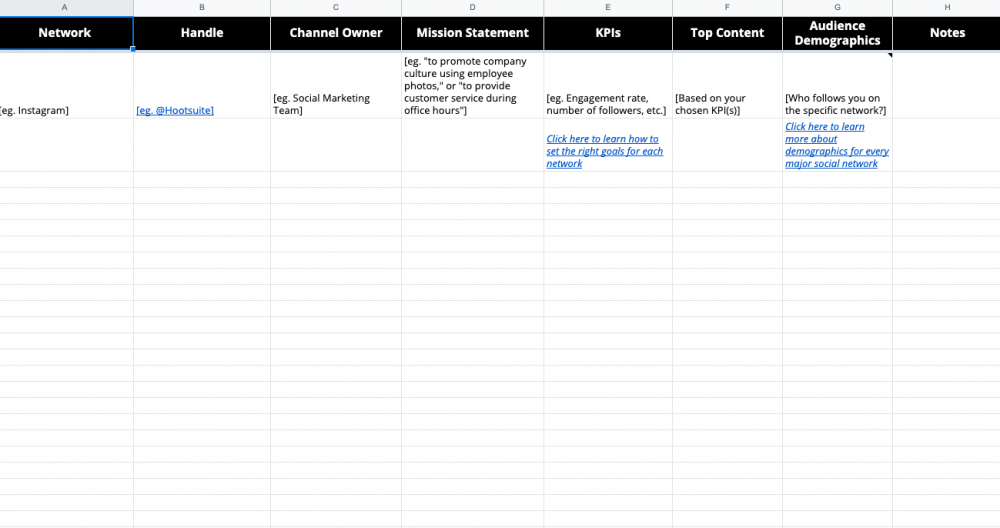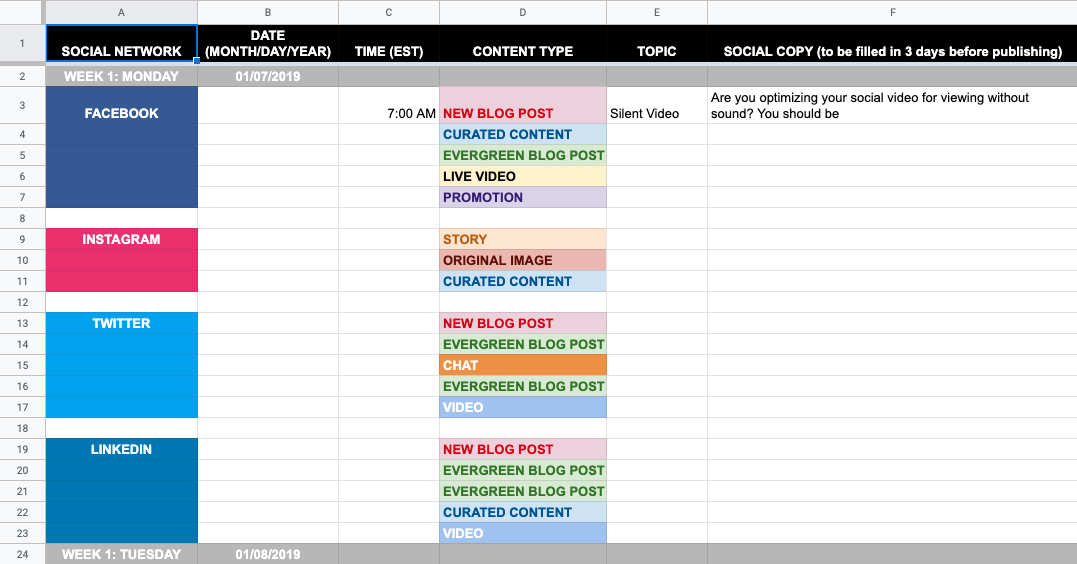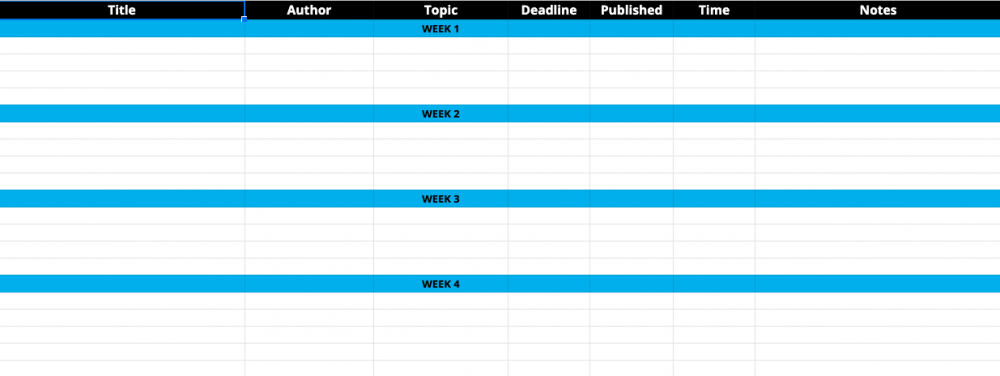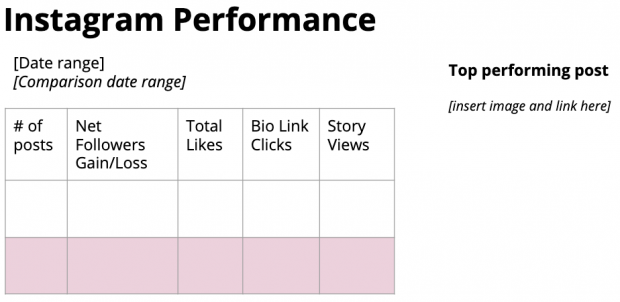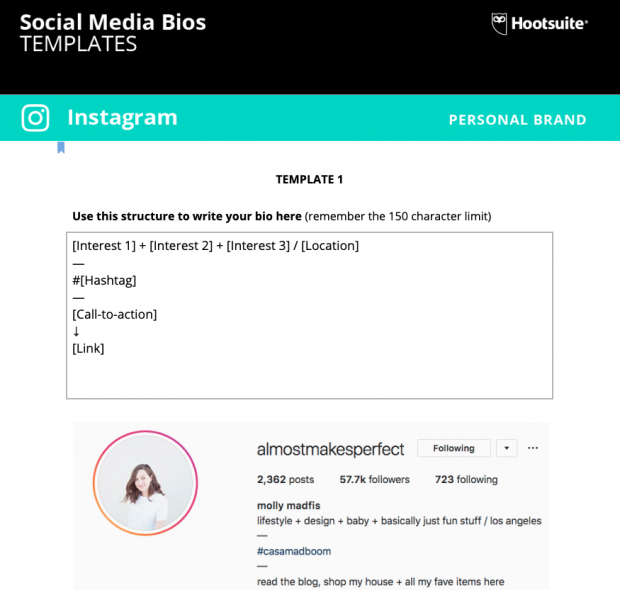Here are 9 social media templates to save you lots of effort and time.
There is one for every stage of your social advertising and marketing journey—from planning and making content, to publishing posts and measuring outcomes.
Fill the social media templates out, customize them, and execute. It’s that easy.
You will see outcomes, too.
1. Social media strategy template
Whether you are beginning from scratch or looking to boost your current social marketing strategy, you want this important resource.
The template makes it simple to:
- Make clear your objectives on social media and how they support your overall business goals
- Conduct research on your ideal customer so you could greater target them
- Gather intel on the competitors so you could stay ahead
- Audit the current state of your social media presence
- Create or enhance all of your social media profiles
- Develop a thoughtful content strategy and set a publishing schedule you could stick to
- Track your progress and adjust your technique as needed
Get the free social media strategy template. To use it in Google Docs, click on the “File” tab and then choose “Make a copy…” from the dropdown menu.
2. Social media audit template
This template will show what’s and is not working on social media—and what to do next. It’s additionally useful for identifying impostor accounts, out-of-date profiles, and new chances to engage your audience.
Gathering these insights will assist you to get the most out of your social marketing budget and resources.
→ Get the free social media audit template. To use it in Google Docs, click on the “File” tab and then choose “Make a duplicate…” from the dropdown menu.
Bonus: the companion article on conducting a social media audit guides you through the process step-by-step.
3. Social media content calendar
This is one of the most necessary tools to include in your social media toolkit.
A social media content calendar allows you to plan and schedule all of your social content in advance for maximum impact.
It’ll also help you:
- Identify and fill gaps in publishing
- Keep in mind important dates and events
- Discover your ideal content mix
- Make sure your content is fresh and performing well
- Collaborate with teammates and effectively allocate resources
- Gain visibility across your group
→ Get the free, customizable social media calendar template. To use it in Google Docs, click on the “File” tab and then choose “Make a copy…” from the dropdown menu.
4. Editorial content calendar
Another kind of calendar favored by social media pros is the editorial content calendar.
This resource will gather all of your content projects into one document to help you plan and schedule each launch.
The simplest method to organize a content calendar is by utilizing a separate tab for each month within Google Sheets or an Excel Spreadsheet for each month. Activities could be broken down by day or hour, relying on the volume and cadence of your content plan.
Your editorial calendar needs to include basic details about each of those projects:
- Title or description of the content
- Links to supporting documents, like content briefs
- Writer or author
- Deadline
- Channels you plan to promote it on
→ Get the basic editorial calendar template and add columns or rows as required. To use it in Google Docs, click on the “File” tab and then choose “Make a copy…” from the dropdown menu.
5. Social media analytics report template
Recording and analyzing social media outcomes is vital to proving the value of your efforts.
However, where to start? We have created a helpful template with a few of the key items you need to record, with tabs to keep observe of metrics for your different social channels. While the key figures might vary for your brand, these basics are necessary for everybody to keep track of.
This template provides you with space to record social media metrics for every major network, together with…
- Followers gained/lost
- Engagement
- Shares
- Views
- Click-throughs
- And much more
→ Get the free social media analytics report template. To use it in Google Docs, click on the “File” tab and then choose “Make a copy…” from the dropdown menu.
6. Social media report template
The social media report template is for presenting outcomes to your boss, clients, teammates, or another stakeholder.
Yes, it’ll embody hard data captured in the analytics report template. However, it additionally consists of space for context and analysis. Both are vital to include when presenting to people who are not as close to your business as you’re.
Use this template to make recommendations, share lessons learned, and make recommendations for future strategies.
→ Get the free social media reporting template. To use it in Google Docs, click on the “File” tab and then choose “Make a copy…” from the dropdown menu.
7. Social media image sizes
Ok, calling this a template may be a bit of a stretch, however, it’ll still save you time on social.
The quick reference resource consists of picture dimensions and specs for a profile, feed, header and adverts photos for every network. And pictures, of course, are key in terms of grabbing the audience’s attention and making the first impression.
→ Get the always-up-to-date social media image size cheat sheet.
8. Social media bios template
Along with your profile picture, your profile’s bio plays a giant role in the first impression you make on followers.
A bio on any platform needs to address six key pieces of information:
- Who you’re
- Where you work
- What you do
- The topics that interest you
- Your brand’s tone
- How somebody could get in touch with you
To ensure you cover your bases, we have made easy-to-use templates out of bios from some of the top brands on social media so you could effortlessly create your own.
Simply fill in the blanks and copy and paste the final product to your profile.
→ Get the free social media bio templates for every network. To use them in Google Docs, click on the “File” tab and then choose “Make a copy…” from the dropdown menu.
9. Bulk upload template
Posting or scheduling social media posts across multiple networks one-by-one could be a big drain on your most precious resource: time.
However, when you use Hootsuite’s social media management tool you could bulk add up to 350 social media messages across networks.
To do so you should create a .CSV file of all of the social messages you would like to add, placed in a particular format:
- Column A: Date and time (24-hour time). The accepted date formats are below. Select one format and use it exclusively throughout:
- day/month/year hour:minute
- month/day/year hour:minute
- year/month/day hour:minute
- year/day/month hour:minute
- Column B: Your message. For Twitter there’s a limit of 280 characters, including the URL (which reserves at most 23 characters).
- Column C: URL (optional). Enter the full URL. You could select to have these automatically shortened to Ow.ly links.
- Times have to be set in the future (at least 10 minutes from upload time).
- Posting times have to finish in either a 5 or a 0, i.e. 10:45 or 10:50. Define only one post per time slot.
- Duplicate posts aren’t allowed (it’s bad social media practice).
Sadly Excel usually causes formatting issues, so we do not recommend utilizing it to build your spreadsheet. We prefer utilizing Google Sheets for creating CSV files. You could also use TextEdit (1.7+) or TextWrangler.
Note: When you decide to use Excel, you will need to tell Excel that that data in column is text and not to be changed or it’ll attempt to convert your dates into a different display that will fail your upload.


